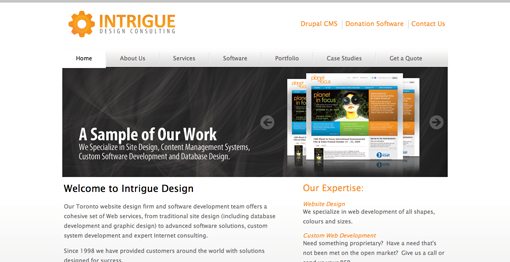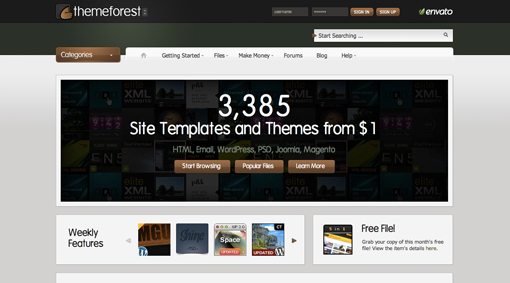5 Ideas for Earning Money Beyond Web Design
Freelancing is an interesting profession. The flow of work is referred to by many as “feast and famine,” meaning that you can generally expect periods of complete overload followed by extended periods of little to no work at all.
With much of the world still attempting to rally from a global economic crisis, many freelancers have taken a serious hit or have even been forced to give up their ventures altogether. Today we’ll go over a few ideas for opening up your horizons and finding sources of income outside of web design.
This article is part two of a four-part series on how to improve your small business or freelance operation. We’ll cover everything from time-saving tools to earning extra money and even deciding on the best career path. Brought to you in partnership with Heart Internet Reseller Hosting.
Print Design
Since I began my career in print, the most obvious transition for me to suggest is print design. Your current skill set perfectly lends itself to other modes of design. You already know how to use the applications (one of the biggest hurdles for many) and should hopefully have a fairly strong grasp of design theory; this is an excellent start!
In many ways, web design and especially web development are more complicated than print design, so starting in web and moving to print can be much easier than making the print-to-web jump. However, that doesn’t mean you can immediately run off and start building catalogues having never taken on a project outside of the digital realm.
Print is still a complicated beast and has many quirks that you’re not used to. For starters, you have to educate yourself on the current state of commercial printing. You need to know what choices are available for substrate, ink, colors, various processes (new and old) and even common pricing structures for printers so you can communicate this information to your client. Sure, you can skate by without familiarizing yourself with the industry, but that’s a lot like taking on web design without knowing anything about the various technologies you can integrate into your designs (hover effects, JavaScript, etc.).
Further, you have to learn to build files in 300dpi CMYK instead of 72dpi RGB. Your computer may handle web files just fine, but wait until you’re building a large high-resolution file to decide if your processor and RAM can handle the work. Switching from RGB to CMYK (not to mention spot colors, fluorescents, etc.) is an interesting transition as well. Your colors can often seem duller and not as vibrant and the realization that what you see on screen may not be what prints is a tough one!
Transitioning Clients
One of the best aspects of print design as a possible extra source of income is that it ties in so closely with what you currently do that you don’t have to start from scratch with your client base. If you’ve designed a website that your client loved, it might not be too hard to convince them to let you take on their business cards, letterhead, flyers, brochures, direct mail campaigns and other print projects.
The print world has an endless array of marketing tools and several strongly performing niches that will never die no matter how much the web replaces common advertising practices. For you this means a strong potential stream of income just waiting to be tapped into.
Consulting
If you have a strong portfolio, it will earn you respect as a knowledgable professional in your field. This can open up doors that you may have never even considered. As one example, how about adding consulting to your selection of services?
You would be surprised at how many businesses, both small and large, are willing to pay good money merely to have your professional opinion as a web designer. This can and does take many forms. Several businesses simply want a second opinion to affirm the work of their current designer. The workflow for you then just involves analyzing what the current designer has done in a similar fashion to how we at Design Shack handle our ongoing Design Critique series.
Other opportunities include businesses that are at the beginning stages of either a large web project or a considerable redesign. It’s often the case that they just need someone to look at their desired system and analyze what it is going to take to build it in terms of technologies, man hours and budget.
There are countless other scenarios where someone needs the brain of a designer. Remember that you are a professional with a very specific talent not possessed by many members of the general public. That knowledge and skill set is valuable far outside merely opening Photoshop and creating projects from the ground up.
Writing
I’ve spent entire articles discussing this subject so I won’t go into too much detail here. Suffice to say that the design blog world is growing rapidly, even to the possible point of over saturation.
What this means for you is that there are tons of websites that really need someone with your knowledge and skill set to write daily, weekly or monthly articles.
To get started, simply start up your own little free blog on Tumblr, WordPress.com or anywhere else you want, then write a few posts that you think are relevant and useful to the design community. Don’t worry about traffic or going all out with designing a custom site, you’re just creating some samples. After you have a few articles under your belt, you can then start sending emails to design blogs. Kindly introduce yourself, tell them you love their blog and would love to help out and leave a few links to your samples.
I can almost guarantee, if you write a standard email and send it to 10-15 sites, as long as you’re a solid writer/designer, you’ll receive more writing opportunities that you have time to handle.
Reseller Hosting
This is an interesting topic that I’m admittedly fairly new to. As a partner of Heart Internet or any other reseller hosting service, you can essentially set up a self-branded web hosting company. The logic for doing this is simple, as a web designer you’ll often be directly in a position to affect where your clients host their sites. As a reseller, you’ll be able to simply add hosting to your list of services.
You don’t have to force your clients into using your service, simply present it as something optional that you offer. If they take it, you earn a residual income for as long as they stay with you for hosting.
The idea of residual or continually recurring income is hard to beat. Rather than working once and getting paid once, you offer a service that takes a one-time effort to set up, and then continues to earn you money while you handle a minimal amount of upkeep.
Selling Themes
This is another topic that I’ve mentioned before on Design Shack and found out pretty quickly that it can be a touchy subject for some designers. A typical fear is that affordable themes are putting good web designers out of work. If a company or individual can buy a beautiful website for $30, why would they pay someone $2,000 to build one?
The problem with this argument is that it’s simply a complaint against someone who came up with a valid business strategy that’s arguably better that your own (remember that you put many print designers out of work!). As much as we designers would love to insist otherwise, it’s simply not always the case that everyone needs a 100% custom-built website.
Hiring someone to spend a few hours customizing something that’s already pre-built for your needs is often a really smart business decision that leads to more profit in that early point when businesses need it the most. Rather than complaining about the designers who build these themes and take your work, shut up and join them!
Selling themes is another great step towards a nice stream of residual income. You often have to engage in considerable customer service and the occasional update, but the largest portion of the work is definitely up front. The downside is that there tends to be plenty of competition, but if your theme does become popular you can often expect to see thousands of dollars in sales.
Conclusion
Don’t settle for small paychecks from months of downtime. If you’re not working as much as you want, take the initiative and go explore some additional opportunities!
This is by no means an exhaustive list, so we want to hear your ideas as well. Leave a comment below and let us know how your skills and experience as a web designer has led to other sources of income.




